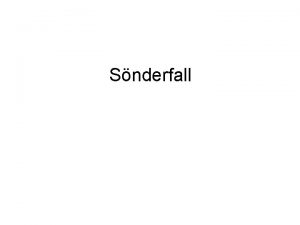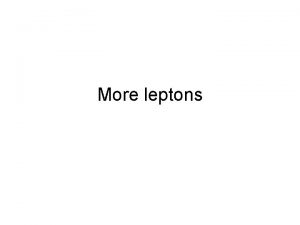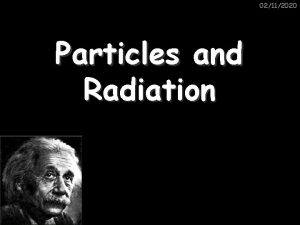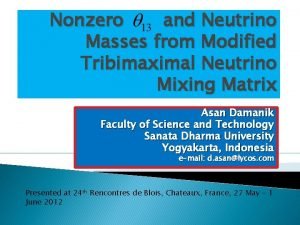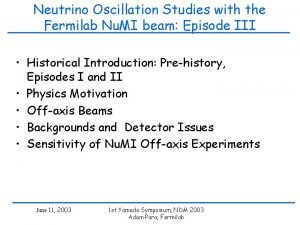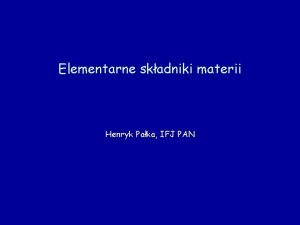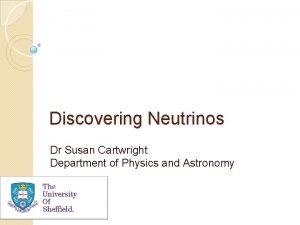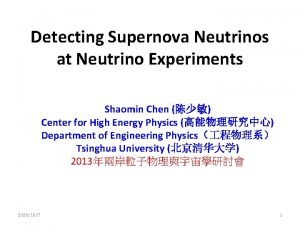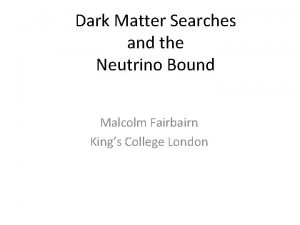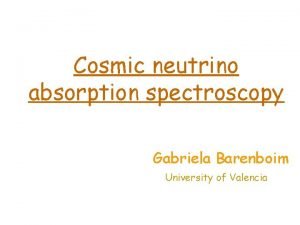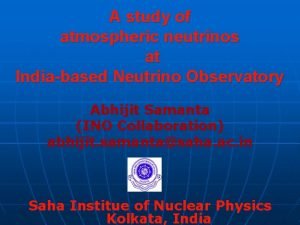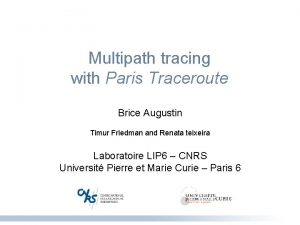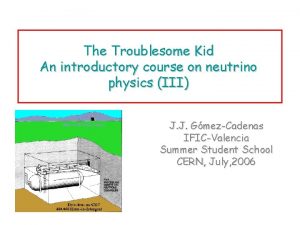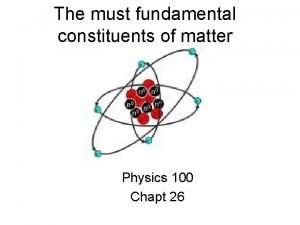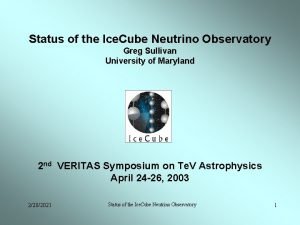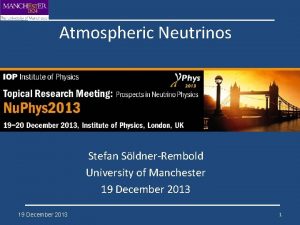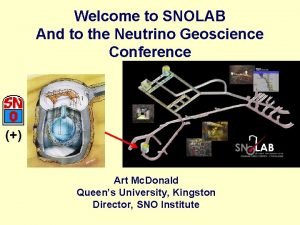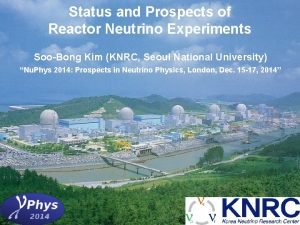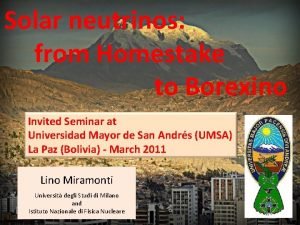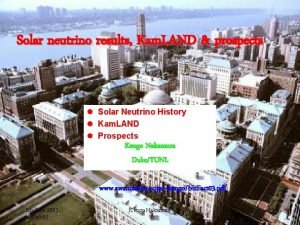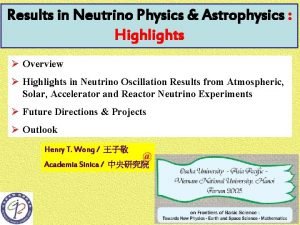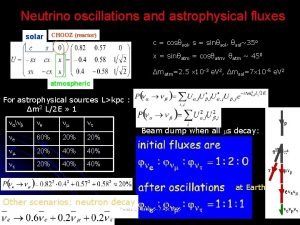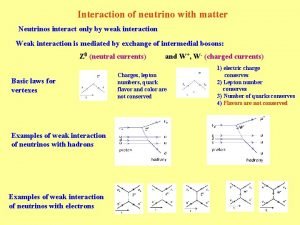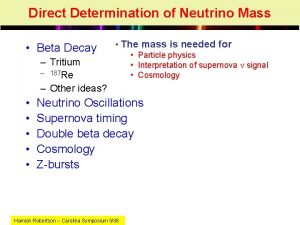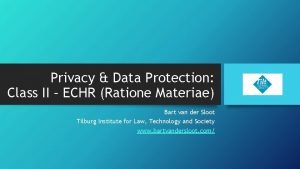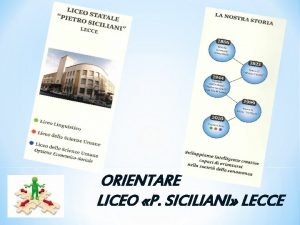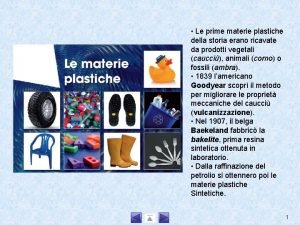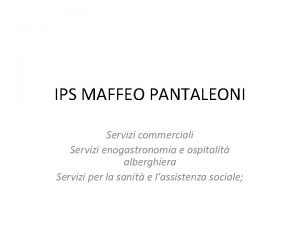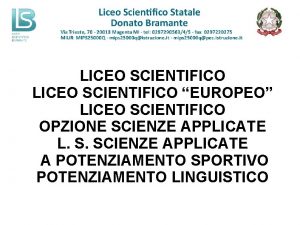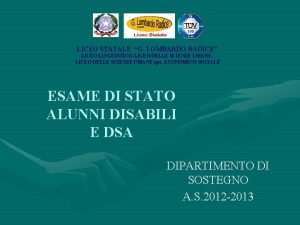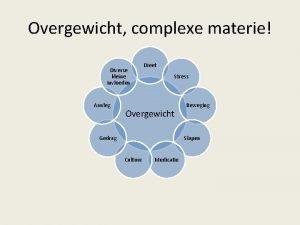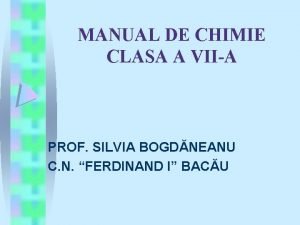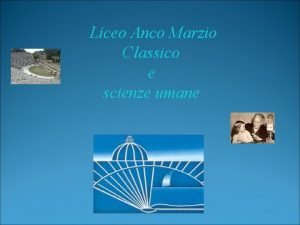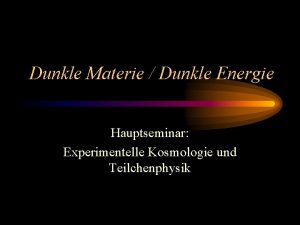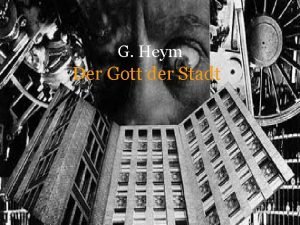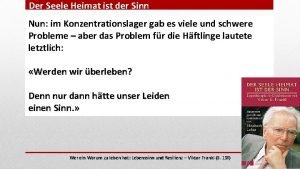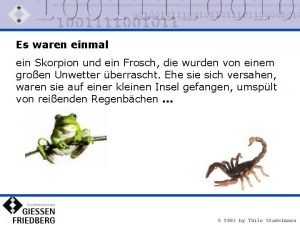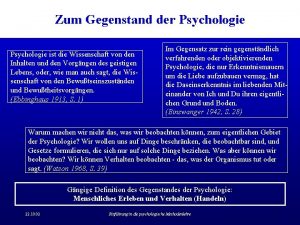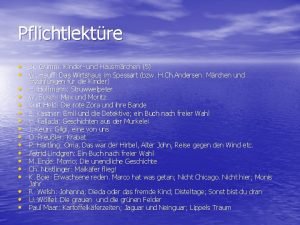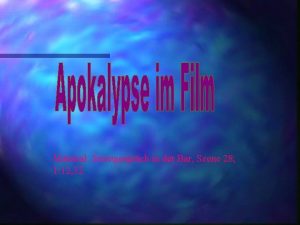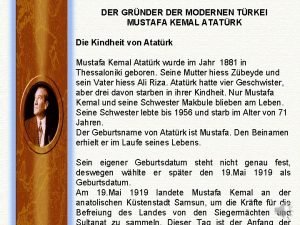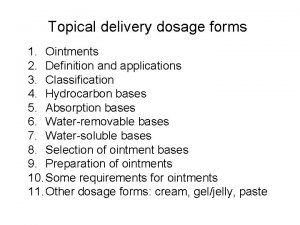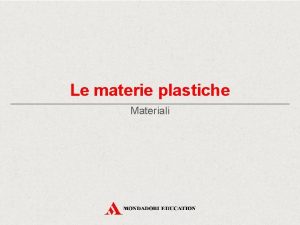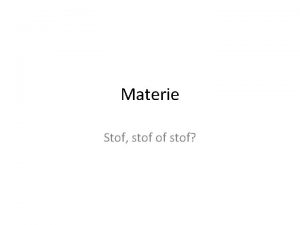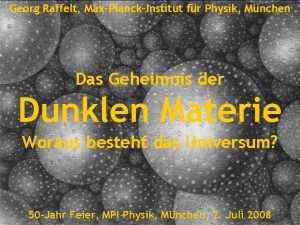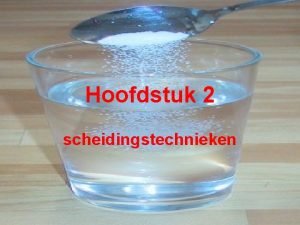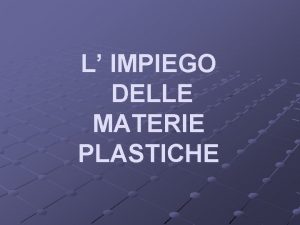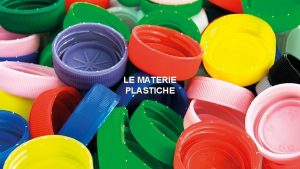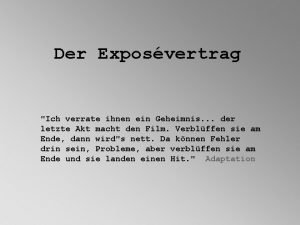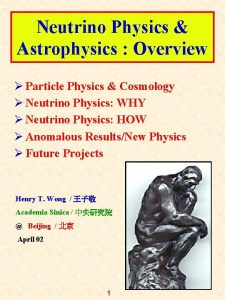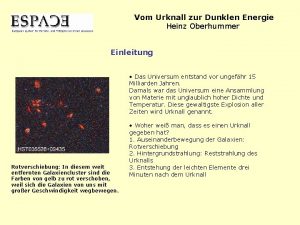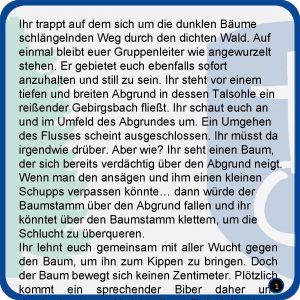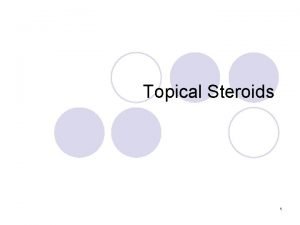Geheimnis der dunklen Materie Topical Seminar Neutrino Physics




























































- Slides: 60

Geheimnis der dunklen Materie Topical Seminar Neutrino Physics & Astrophysics 17 -21 Sept 2008, Beijing, China The Dark Universe, Neutrinos, and Cosmological Mass Bounds Georg Raffelt, Max-Planck-Institut für Physik, München, Germany Neutrino Physics & Astrophysics, 17 -21 Sept 2008, Beijing, China

Thomas Wright (1750), An Original Theory of the Universe Georg Raffelt, Max-Planck-Institut für Physik, München, Germany Neutrino Physics & Astrophysics, 17 -21 Sept 2008, Beijing, China

Title Dark Energy 73% (Cosmological Constant) Ordinary Matter 4% (of this only about 10% luminous) Georg Raffelt, Max-Planck-Institut für Physik, München, Germany Dark Matter 23% Neutrinos 0. 1 -2% Neutrino Physics & Astrophysics, 17 -21 Sept 2008, Beijing, China

Dark Matter in Galaxy Clusters A gravitationally bound system of many particles obeys the virial theorem Velocity dispersion from Doppler shifts and geometric size Coma Cluster Georg Raffelt, Max-Planck-Institut für Physik, München, Germany Total Mass Neutrino Physics & Astrophysics, 17 -21 Sept 2008, Beijing, China

Dark Matter in Galaxy Clusters Fritz Zwicky: Die Rotverschiebung von Extragalaktischen Nebeln (The redshift of extragalactic nebulae) Helv. Phys. Acta 6 (1933) 110 In order to obtain the observed average Doppler effect of 1000 km/s or more, the average density of the Coma cluster would have to be at least 400 times larger than what is found from observations of the luminous matter. Should this be confirmed one would find the surprising result that dark matter is far more abundant than luminous matter. Georg Raffelt, Max-Planck-Institut für Physik, München, Germany Neutrino Physics & Astrophysics, 17 -21 Sept 2008, Beijing, China

Structure of Spiral Galaxies Spiral Galaxy NGC 2997 Georg Raffelt, Max-Planck-Institut für Physik, München, Germany Spiral Galaxy NGC 891 Neutrino Physics & Astrophysics, 17 -21 Sept 2008, Beijing, China

Galactic Rotation Curve from Radio Observations Observed flat rotation curve Expected from luminous matter in the disk Spiral galaxy NGC 3198 overlaid with hydrogen column density [Ap. J 295 (1985) 305] Georg Raffelt, Max-Planck-Institut für Physik, München, Germany Rotation curve of the galaxy NGC 6503 from radio observations of hydrogen motion [MNRAS 249 (1991) 523] Neutrino Physics & Astrophysics, 17 -21 Sept 2008, Beijing, China

Structure of a Spiral Galaxy Dark Halo Georg Raffelt, Max-Planck-Institut für Physik, München, Germany Neutrino Physics & Astrophysics, 17 -21 Sept 2008, Beijing, China

Expanding Universe and the Big Bang • Photons • Neutrinos • Charged Leptons • Quarks • Gluons • W- and Z-Bosons • Higgs Particles • Gravitons • Dark-Matter Particles • Topological defects • … Hubble’s law vexpansion = H 0 distance Hubble’s constant H 0 = h 100 km s-1 Mpc-1 Measured value h = 0. 72 0. 04 1 Mpc = 3. 26 106 lyr = 3. 08 1024 cm Expansion age of the universe t 0 H 0 -1 14 109 years Georg Raffelt, Max-Planck-Institut für Physik, München, Germany Neutrino Physics & Astrophysics, 17 -21 Sept 2008, Beijing, China

Big Bang Georg Raffelt, Max-Planck-Institut für Physik, München, Germany Neutrino Physics & Astrophysics, 17 -21 Sept 2008, Beijing, China

Cosmic Expansion Cosmic Scale Factor Cosmic Redshift • Space between galaxies grows • Galaxies (stars, people) stay the same (dominated by local gravity or by electromagnetic forces) • Cosmic scale factor today: a = 1 • Wavelength of light gets “stretched” Georg Raffelt, Max-Planck-Institut für Physik, München, Germany • Suffers redshift • Redshift today: z = 0 Neutrino Physics & Astrophysics, 17 -21 Sept 2008, Beijing, China

Friedman Equation & Einstein’s “Greatest Blunder” Density of gravitating mass & energy Newton’s constant Curvature term is very small or zero (Euclidean spatial geometry) Friedmann equation for Hubble’s expansion rate Yakov Borisovich Zeldovich 1914 -1987 Cosmological constant L (new constant of nature) allows for a static universe by “global anti-gravitation” • Quantum field theory of elementary particles inevitably implies vacuum fluctuations because of Heisenberg’s uncertainty relation, e. g. E and B fields can not simultaneously vanish • Ground state (vacuum) provides gravitating energy • Vacuum energy rvac is equivalent to L Georg Raffelt, Max-Planck-Institut für Physik, München, Germany Neutrino Physics & Astrophysics, 17 -21 Sept 2008, Beijing, China

Generic Solutions of Friedmann Equation Behavior of energy-density under of state cosmic expansion Evolution of cosmic scale factor Radiation p = r/3 r a-4 Dilution of radiation and redshift of energy a(t) t 1/2 Matter p=0 r a-3 Dilution of matter a(t) t 2/3 Vacuum energy p = -r r = const Vacuum energy not diluted by expansion Energy-momentum tensor of perfect fluid with density r and pressure p Georg Raffelt, Max-Planck-Institut für Physik, München, Germany Neutrino Physics & Astrophysics, 17 -21 Sept 2008, Beijing, China

Hubble Diagram Apparent Brightness Supernova Ia as cosmological standard candles Hubble’s orginal data (1929) Redshift z = 0. 003 Georg Raffelt, Max-Planck-Institut für Physik, München, Germany Neutrino Physics & Astrophysics, 17 -21 Sept 2008, Beijing, China

Hubble Diagram Supernova Ia as cosmological standard candles Accelerated expansion ( M = 0. 3, L = 0. 7) Decelerated expansion ( M = 1) Georg Raffelt, Max-Planck-Institut für Physik, München, Germany Neutrino Physics & Astrophysics, 17 -21 Sept 2008, Beijing, China

Latest Supernova Data Kowalski et al. , Improved cosmological constraints from new, old and combined supernova datasets, ar. Xiv: 0804. 4142 Georg Raffelt, Max-Planck-Institut für Physik, München, Germany Neutrino Physics & Astrophysics, 17 -21 Sept 2008, Beijing, China

Expansion of Different Cosmological Models M = 0. 3 L = 0. 7 Cosmic scale factor a M = 0 M = 1 M > 1 -14 -9 -7 today Time (billion years) Adapted from Bruno Leibundgut Georg Raffelt, Max-Planck-Institut für Physik, München, Germany Neutrino Physics & Astrophysics, 17 -21 Sept 2008, Beijing, China

Title Dark Energy 73% (Cosmological Constant) Ordinary Matter 4% (of this only about 10% luminous) Georg Raffelt, Max-Planck-Institut für Physik, München, Germany Dark Matter 23% Neutrinos 0. 1 -2% Neutrino Physics & Astrophysics, 17 -21 Sept 2008, Beijing, China

Neutrino Thermal Equilibrium Neutrino reactions Cosmic expansion rate Examples for neutrino processes GF Dimensional analysis of reaction rate if T ≪ m. W, Z Friedmann equation Radiation dominates Expansion rate Condition for thermal equilibrium: G > H Neutrinos are in thermal equilibrium for T ≳ 1 Me. V corresponding to t ≲ 1 sec Georg Raffelt, Max-Planck-Institut für Physik, München, Germany Neutrino Physics & Astrophysics, 17 -21 Sept 2008, Beijing, China

Present-Day Neutrino Density Neutrino decoupling (freeze out) Redshift of Fermi-Dirac distribution (“nothing changes at freeze-out”) Electron-positron annihilation beginning at T me = 0. 511 Me. V Redshift of neutrino and photon thermal distributions so that today we have Georg Raffelt, Max-Planck-Institut für Physik, München, Germany H~G T 2. 4 Me. V T 3. 7 Me. V (electron flavor) (other flavors) Temperature scales with redshift Tn = Tg (z+1) • QED plasma is “strongly” coupled • Stays in thermal equilibrium (adiabatic process) • Entropy of e+e- transfered to photons for massless neutrinos Neutrino Physics & Astrophysics, 17 -21 Sept 2008, Beijing, China

Cosmological Limit on Neutrino Masses Cosmic neutrino “sea” ~ 112 cm-3 neutrinos + anti-neutrinos per flavor mn ≲ 40 e. V For all stable flavors A classic paper: Gershtein & Zeldovich JETP Lett. 4 (1966) 120 Georg Raffelt, Max-Planck-Institut für Physik, München, Germany Neutrino Physics & Astrophysics, 17 -21 Sept 2008, Beijing, China

Weakly Interacting Particles as Dark Matter • More than 30 years ago, beginnings of the idea of weakly interacting particles (neutrinos) as dark matter • Massive neutrinos are no longer a good candidate (hot dark matter) However, the idea of weakly interacting massive particles as dark matter is now standard Georg Raffelt, Max-Planck-Institut für Physik, München, Germany Neutrino Physics & Astrophysics, 17 -21 Sept 2008, Beijing, China

What is wrong with neutrino dark matter? Galactic Phase Space (“Tremaine-Gunn-Limit”) Maximum mass density of a degenerate Fermi gas mn > 20 - 40 e. V Spiral galaxies mn > 100 - 200 e. V Dwarf galaxies Neutrino Free Streaming (Collisionless Phase Mixing) • At T < 1 Me. V neutrino scattering in early universe ineffective • Stream freely until non-relativistic • Wash out density contrasts on small scales Neutrinos Over-density Georg Raffelt, Max-Planck-Institut für Physik, München, Germany • Nus are “Hot Dark Matter” • Ruled out by structure formation Neutrino Physics & Astrophysics, 17 -21 Sept 2008, Beijing, China

Sky Distribution of Galaxies (XMASS XSC) http: //spider. ipac. caltech. edu/staff/jarrett/2 mass/XSC/jarrett_allsky. html Neutrino Physics & Astrophysics, 17 -21 Sept 2008, Beijing, China Georg Raffelt, Max-Planck-Institut für Physik, München, Germany

A Slice of the Universe Cosmic “Stick Man” ~1 85 Mp c Galaxy distribution from the Cf. A redshift survey [Ap. J 302 (1986) L 1] Georg Raffelt, Max-Planck-Institut für Physik, München, Germany Neutrino Physics & Astrophysics, 17 -21 Sept 2008, Beijing, China

2 d. F Galaxy Redshift Survey (2002) ~ 00 13 c Mp Georg Raffelt, Max-Planck-Institut für Physik, München, Germany Neutrino Physics & Astrophysics, 17 -21 Sept 2008, Beijing, China

SDSS Survey Georg Raffelt, Max-Planck-Institut für Physik, München, Germany Neutrino Physics & Astrophysics, 17 -21 Sept 2008, Beijing, China

Generating the Primordial Density Fluctuations Early phase of exponential expansion (Inflationary epoch) Zero-point fluctuations of quantum fields are stretched and frozen Cosmic density fluctuations are frozen quantum fluctuations Georg Raffelt, Max-Planck-Institut für Physik, München, Germany Neutrino Physics & Astrophysics, 17 -21 Sept 2008, Beijing, China

Gravitational Growth of Density Perturbations The dynamical evolution of small perturbations is independent for each Fourier mode dk • For pressureless, nonrelativistic matter (cold dark matter) naively expect exponential growth • Only power-law growth in expanding universe Georg Raffelt, Max-Planck-Institut für Physik, München, Germany Radiation dominates a t 1/2 Matter dominates a t 2/3 Sub-horizon l ≪ H-1 Super-horizon l ≫ H-1 dk const dk a 2 t dk a t 2/3 Neutrino Physics & Astrophysics, 17 -21 Sept 2008, Beijing, China

Structure Formation by Gravitational Instability Georg Raffelt, Max-Planck-Institut für Physik, München, Germany Neutrino Physics & Astrophysics, 17 -21 Sept 2008, Beijing, China

Redshift Surveys vs. Millenium Simulation www. mpa-garching. mpg. de/millennium Georg Raffelt, Max-Planck-Institut für Physik, München, Germany Neutrino Physics & Astrophysics, 17 -21 Sept 2008, Beijing, China

Power Spectrum of Density Fluctuations Field of density fluctuations Gaussian random field (phases of Fourier modes dk uncorrelated) is fully characterized by the power spectrum Fourier transform Power spectrum essentially square of Fourier transformation with or equivalently by the d-function Power spectrum is Fourier transform of two-point correlation function (x=x 2 -x 1) Georg Raffelt, Max-Planck-Institut für Physik, München, Germany Neutrino Physics & Astrophysics, 17 -21 Sept 2008, Beijing, China

Processed Power Spectrum in Cold Dark Matter Scenario Primordial spectrum Suppressed by stagnation during radiation phase Primordial spectrum usually assumed to be of power-law form Harrison-Zeldovich (“flat”) spectrum n=1 expected from inflation (actually slightly less than 1, as confirmed by precision data) Georg Raffelt, Max-Planck-Institut für Physik, München, Germany Neutrino Physics & Astrophysics, 17 -21 Sept 2008, Beijing, China

Power Spectrum of Cosmic Density Fluctuations Georg Raffelt, Max-Planck-Institut für Physik, München, Germany Neutrino Physics & Astrophysics, 17 -21 Sept 2008, Beijing, China

Cosmic Microwave Background Radiation Robert W. Wilson Born 1936 Arno A. Penzias Born 1933 Discovery of 2. 7 Kelvin Cosmic microwave background radiation by Penzias and Wilson in 1965 (Nobel Prize 1978) Beginning of “big-bang cosmology” Georg Raffelt, Max-Planck-Institut für Physik, München, Germany Neutrino Physics & Astrophysics, 17 -21 Sept 2008, Beijing, China

Last Scattering Surface 10 15 00 00 Q 20 Hor izon 3 1 Here & Now Redshift z Georg Raffelt, Max-Planck-Institut für Physik, München, Germany Neutrino Physics & Astrophysics, 17 -21 Sept 2008, Beijing, China

COBE Temperature Map of the Cosmic Microwave Background -3) -5 Dynamical range D T = 3. 353 m. K ( D T/ T 10 Dynamical range DT = 18 m. K (DT/ T 10 ) T = 2. 725 K (uniform on the. Doppler sky) Dipole temperature distribution from effect Primordial temperature fluctuations caused by our motion relative to the cosmic frame Georg Raffelt, Max-Planck-Institut für Physik, München, Germany Neutrino Physics & Astrophysics, 17 -21 Sept 2008, Beijing, China

COBE Satellite Nobel Prize 2006 John C. Mather Born 1946 Georg Raffelt, Max-Planck-Institut für Physik, München, Germany George F. Smoot Born 1945 Neutrino Physics & Astrophysics, 17 -21 Sept 2008, Beijing, China

Power Spectrum of CMBR Temperature Fluctuations Sky map of CMBR temperature fluctuations Multipole expansion Acoustic Peaks Angular power spectrum Georg Raffelt, Max-Planck-Institut für Physik, München, Germany Neutrino Physics & Astrophysics, 17 -21 Sept 2008, Beijing, China

Flat Universe from CMBR Angular Fluctuations Spergel et al. (WMAP Collaboration) astro-ph/0302209 Triangulation with acoustic peak flat (Euclidean) negative curvature positive curvature tot = 1. 02 0. 02 Georg Raffelt, Max-Planck-Institut für Physik, München, Germany Known physical size of acoustic peak at decoupling (z 1100) Measured angular size today (z = 0) Neutrino Physics & Astrophysics, 17 -21 Sept 2008, Beijing, China

Latest CMB Results (WMAP-5 and Others) Komatsu et al. , ar. Xiv: 0803. 0547 Georg Raffelt, Max-Planck-Institut für Physik, München, Germany Neutrino Physics & Astrophysics, 17 -21 Sept 2008, Beijing, China

Best-Fit Universe Perlmutter Physics Today (Apr. 2003) Georg Raffelt, Max-Planck-Institut für Physik, München, Germany Kowalski et al. ar. Xiv: 0804. 4142 Neutrino Physics & Astrophysics, 17 -21 Sept 2008, Beijing, China

Concordance Model of Cosmology A Friedmann-Lemaître-Robertson-Walker model with the following parameters perfectly describes the global properties of the universe Expansion rate Spatial curvature Age Vacuum energy Cold Dark Matter Baryonic matter The observed large-scale structure and CMBR temperature fluctuations are perfectly accounted for by the gravitational instability mechanism with the above ingredients and a power-law primordial spectrum of adiabatic density fluctuations (curvature fluctuations) P(k) kn Power-law index Georg Raffelt, Max-Planck-Institut für Physik, München, Germany Neutrino Physics & Astrophysics, 17 -21 Sept 2008, Beijing, China

Structure Formation in the Universe Smooth Structured Structure forms by gravitational instability of primordial density fluctuations A fraction of hot dark matter suppresses small-scale structure Georg Raffelt, Max-Planck-Institut für Physik, München, Germany Neutrino Physics & Astrophysics, 17 -21 Sept 2008, Beijing, China

Structure Formation with Hot Dark Matter Standard LCDM Model Neutrinos with Smn = 6. 9 e. V Structure fromation simulated with Gadget code Cube size 256 Mpc at zero redshift Troels Haugbølle, http: //whome. phys. au. dk/~haugboel Georg Raffelt, Max-Planck-Institut für Physik, München, Germany Neutrino Physics & Astrophysics, 17 -21 Sept 2008, Beijing, China

Neutrino Free Streaming: Transfer Function Power suppression for l. FS ≳ 100 Mpc/h mn = 0. 3 e. V mn = 1 e. V Transfer function P(k) = T(k) P 0(k) Effect of neutrino free streaming on small scales T(k) = 1 - 8 n/ M valid for 8 n / M ≪ 1 Hannestad, Neutrinos in Cosmology, hep-ph/0404239 Georg Raffelt, Max-Planck-Institut für Physik, München, Germany Neutrino Physics & Astrophysics, 17 -21 Sept 2008, Beijing, China

Power Spectrum of Cosmic Density Fluctuations Georg Raffelt, Max-Planck-Institut für Physik, München, Germany Neutrino Physics & Astrophysics, 17 -21 Sept 2008, Beijing, China

Some Recent Cosmological Limits on Neutrino Masses Smn/e. V Data / Priors (limit 95%CL) Hannestad 2003 1. 01 [astro-ph/0303076] WMAP-1, CMB, 2 d. F, HST Spergel et al. (WMAP) 2003 0. 69 [astro-ph/0302209] WMAP-1, 2 d. F, HST, s 8 Crotty et al. 2004 [hep-ph/0402049] 1. 0 0. 6 WMAP-1, CMB, 2 d. F, SDSS & HST, SN Hannestad 2004 [hep-ph/0409108] 0. 65 WMAP-1, SDSS, SN Ia gold sample, Ly-a data from Keck sample Seljak et al. 2004 0. 42 [astro-ph/0407372] WMAP-1, SDSS, Bias, Ly-a data from SDSS sample Hannestad et al. 2006 [hep-ph/0409108] 0. 30 WMAP-1, CMB-small, SDSS, 2 d. F, SN Ia, BAO (SDSS), Ly-a (SDSS) Spergel et al. 2006 [hep-ph/0409108] 0. 68 WMAP-3, SDSS, 2 d. F, SN Ia, s 8 Seljak et al. 2006 0. 14 [astro-ph/0604335] Georg Raffelt, Max-Planck-Institut für Physik, München, Germany WMAP-3, CMB-small, SDSS, 2 d. F, SN Ia, BAO (SDSS), Ly-a (SDSS) Neutrino Physics & Astrophysics, 17 -21 Sept 2008, Beijing, China

Lyman-alpha Forest • Hydrogen clouds absorb from QSO continuum emission spectrum • Absorption dips at Ly-a wavelengh corresponding to redshift www. astro. ucla. edu/~wright/Lyman-alpha-forest. html Examples for Lyman-a forest in low- and high-redshift quasars http: //www. astr. ua. edu/keel/agn/forest. gif Georg Raffelt, Max-Planck-Institut für Physik, München, Germany Neutrino Physics & Astrophysics, 17 -21 Sept 2008, Beijing, China

Weak Lensing - A Powerful Probe for the Future Distortion of background images by foreground matter Unlensed Georg Raffelt, Max-Planck-Institut für Physik, München, Germany Lensed Neutrino Physics & Astrophysics, 17 -21 Sept 2008, Beijing, China

Sensitivity Forecasts for Future LSS Observations Lesgourgues, Pastor & Perotto, hep-ph/0403296 Planck & SDSS Smn > 0. 21 e. V detectable at 2 s Ideal CMB & 40 x SDSS Smn > 0. 13 e. V detectable at 2 s Abazajian & Dodelson astro-ph/0212216 Future weak lensing survey 4000 deg 2 σ(mν) ~ 0. 1 e. V Kaplinghat, Knox & Song, CMB lensing astro-ph/0303344 σ(mν) ~ 0. 15 e. V (Planck) σ(mν) ~ 0. 044 e. V (CMBpol) Wang, Haiman, Hu, Khoury & May, astro-ph/0505390 Weak-lensing selected sample of > 105 clusters Hannestad, Tu & Wong astro-ph/0603019 Weak-lensing tomography σ(mν) ~ 0. 05 e. V (LSST plus Planck) Georg Raffelt, Max-Planck-Institut für Physik, München, Germany σ(mν) ~ 0. 03 e. V Neutrino Physics & Astrophysics, 17 -21 Sept 2008, Beijing, China

Fermion Mass Spectrum Quarks (Q = -1/3) d Quarks (Q = +2/3) Charged Leptons (Q = -1) s u e b c m t t All flavors n 3 Neutrinos 1 10 100 1 10 100 1 me. V ke. V Me. V Ge. V Te. V Georg Raffelt, Max-Planck-Institut für Physik, München, Germany Neutrino Physics & Astrophysics, 17 -21 Sept 2008, Beijing, China

“Weighing” Neutrinos with KATRIN • Sensitive to common mass scale m for all flavors because of small mass differences from oscillations • Best limit from Mainz und Troitsk m < 2. 2 e. V (95% CL) • KATRIN can reach 0. 2 e. V • Under construction • Data taking foreseen to begin in 2009 http: //www-ik. fzk. de/katrin/ Georg Raffelt, Max-Planck-Institut für Physik, München, Germany Neutrino Physics & Astrophysics, 17 -21 Sept 2008, Beijing, China

“KATRIN Approaching” (25 Nov 2006) Georg Raffelt, Max-Planck-Institut für Physik, München, Germany Neutrino Physics & Astrophysics, 17 -21 Sept 2008, Beijing, China

Lee-Weinberg Curve for Neutrinos and Axions Non-Thermal Relics log( a) Axions M HDM CDM 10 me. V 10 e. V log( n) Neutrinos & WIMPs Thermal Relics log(ma) Thermal Relics HDM CDM M log(mn) 10 e. V Georg Raffelt, Max-Planck-Institut für Physik, München, Germany 10 Ge. V Neutrino Physics & Astrophysics, 17 -21 Sept 2008, Beijing, China

Axion Hot Dark Matter from Thermalization after LQCD Cosmic thermal degrees of freedom Freeze-out temperature 104 105 106 fa (Ge. V) 107 Cosmic thermal degrees of freedom at axion freeze-out p p p a Chang & Choi, PLB 316 (1993) 51 Hannestad, Mirizzi & Raffelt, JCAP 07 (2005) 02 Georg Raffelt, Max-Planck-Institut für Physik, München, Germany 104 105 106 107 fa (Ge. V) Neutrino Physics & Astrophysics, 17 -21 Sept 2008, Beijing, China

Low-Mass Particle Densities in the Universe Photons Neutrinos Axions (QCD) ALPs (two photon vertex) Cosmic microwave background radiation T = 2. 725 K Freeze out at T ~ 2 -3 Me. V before e-e+ annihilation 410 cm-3 ( 112 cm-3 in one flavor) For fa ~ 107 Ge. V (ma ~ 1 e. V) Freeze out at T ~ 80 Me. V (pppa interaction) ~ 50 cm-3 Primakoff freeze out (gagg ~ 10 -10 Ge. V-1) T ≫ TQCD ~ 200 Me. V < 10 cm-3 • No useful hot dark matter limit on ALPs in the CAST search range (too few of them today if they couple only by two-photon vertex) • Axion mass limit comparable to limit on Smn (Axion number density comparable to one neutrino flavor) Georg Raffelt, Max-Planck-Institut für Physik, München, Germany Neutrino Physics & Astrophysics, 17 -21 Sept 2008, Beijing, China

Axion Hot Dark Matter Limits from Precision Data Credible regions for neutrino plus axion hot dark matter (WMAP-5, LSS, BAO, SNIa) Hannestad, Mirizzi, Raffelt & Wong [ar. Xiv: 0803. 1585] Dashed (red) curves: Same with WMAP-3 From HMRW [ar. Xiv: 0706. 4198] Marginalizing over unknown neutrino hot dark matter component ma < 1. 0 e. V (95% CL) WMAP-5, LSS, BAO, SNIa Hannestad, Mirizzi, Raffelt & Wong [ar. Xiv: 0803. 1585] ma < 0. 4 e. V (95% CL) WMAP-3, small-scale CMB, HST, BBN, LSS, Ly-a Melchiorri, Mena & Slosar [ar. Xiv: 0705. 2695] Georg Raffelt, Max-Planck-Institut für Physik, München, Germany Neutrino Physics & Astrophysics, 17 -21 Sept 2008, Beijing, China

Axion Bounds 103 ma 106 ke. V Experiments 109 me. V Tele CAST scope Too much hot dark matter [Ge. V] fa 1012 me. V Direct search ADMX Too much cold dark matter Globular clusters (a-g-coupling) Too many events Too much energy loss SN 1987 A (a-N-coupling) Georg Raffelt, Max-Planck-Institut für Physik, München, Germany Neutrino Physics & Astrophysics, 17 -21 Sept 2008, Beijing, China

Title Inner space and outer space are closely related Georg Raffelt, Max-Planck-Institut für Physik, München, Germany Neutrino Physics & Astrophysics, 17 -21 Sept 2008, Beijing, China
 Neutrino beteckning
Neutrino beteckning Neutrino lepton number
Neutrino lepton number Neutrino lepton number
Neutrino lepton number Neutrino
Neutrino Neutrino
Neutrino Lekka cząstka elementarna mion elektron lub neutrino
Lekka cząstka elementarna mion elektron lub neutrino Dr susan cartwright
Dr susan cartwright Neutrino
Neutrino Neutrino
Neutrino Gabriela barenboim
Gabriela barenboim Neutrino
Neutrino Paris traceroute
Paris traceroute Neutrino
Neutrino Neutrino symbol
Neutrino symbol Ice cube status
Ice cube status Neutrino
Neutrino Solar neutrino
Solar neutrino Neutrino
Neutrino Solar neutrino
Solar neutrino Solar neutrino
Solar neutrino Neutrino mass
Neutrino mass Neutrino
Neutrino Neutrino interaction with matter
Neutrino interaction with matter Neutrino mass
Neutrino mass Rationae materiae
Rationae materiae Liceo siciliani
Liceo siciliani Chimica macromolecolare
Chimica macromolecolare Istituto deffenu olbia
Istituto deffenu olbia Itc baggi sassuolo
Itc baggi sassuolo Maffeo pantaleoni indirizzi
Maffeo pantaleoni indirizzi Liceo scientifico europeo materie
Liceo scientifico europeo materie Einaudi scuola lodi
Einaudi scuola lodi Lombardo radice scienze umane materie
Lombardo radice scienze umane materie Liceo scienze umane anco marzio
Liceo scienze umane anco marzio Complexe materie
Complexe materie Manual dirigentie clasa 7
Manual dirigentie clasa 7 Liceo anco marzio roma
Liceo anco marzio roma Istituto cicognini rodari
Istituto cicognini rodari Lavorazione delle materie plastiche schema
Lavorazione delle materie plastiche schema Baggi sassuolo materie
Baggi sassuolo materie Dunkle energie
Dunkle energie Ruffini genova materie
Ruffini genova materie Auf einem häuserblocke sitzt er breit
Auf einem häuserblocke sitzt er breit Der seele heimat ist der sinn
Der seele heimat ist der sinn Der weg der atemluft
Der weg der atemluft Geschichte frosch skorpion
Geschichte frosch skorpion Gegenstand der psychologie beispiel
Gegenstand der psychologie beispiel Der daumen pflückt die pflaumen
Der daumen pflückt die pflaumen Weltuntergangstheorie
Weltuntergangstheorie Aufbau einer burg im mittelalter
Aufbau einer burg im mittelalter Erste tag der woche
Erste tag der woche Sorrowing old man painting
Sorrowing old man painting Wer ist der gründer der modernen türkei
Wer ist der gründer der modernen türkei Why does it happen
Why does it happen University physics with modern physics fifteenth edition
University physics with modern physics fifteenth edition Simple physics ia ideas
Simple physics ia ideas Guidelines for writing a literature review
Guidelines for writing a literature review Enema dosage form
Enema dosage form Cold cream definition in pharmacy
Cold cream definition in pharmacy Topical agents definition
Topical agents definition Types of syllabus
Types of syllabus
